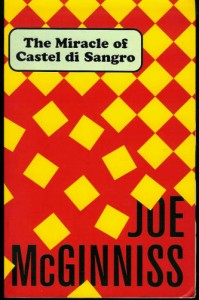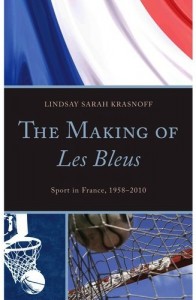 Joe McGinniss had a love affair with soccer.
Joe McGinniss had a love affair with soccer.
The award-winning author and journalist died on March 10, 2014, of prostate cancer at the age of 71 (read an obituary here). I got to know Joe pretty well in the late 1990s while he was writing The Miracle of Castel di Sangro, one of the very first commercially viable books written by an American member of the soccerati class.
I was working on my PhD in African history at Boston University at the time and also teaching a course on “Soccer and Imperialism” at Tufts University. My mother had sent me a Corriere della Sera article about Joe chronicling Castel di Sangro’s 1996-97 serie B season for a David-versus-Goliath book about the team from an Apennine town of 5,000 souls competing just one tier below serie A, then the best league in the world.
As a fútbologist born and raised in Rome, I was naturally intrigued. So I wrote him a concise letter introducing myself and suggesting that given our shared love of calcio it would be nice to meet some time in the near future. Next thing I know Joe got in touch and we met at a Legal Seafoods at Boston’s Logan Airport. He was about to fly back to Italy for what would turn out to be an unexpectedly eventful end to his season in Castel di Sangro.
After the usual pleasantries the talk immediately turned to Italy, football, and especially Roberto Baggio. We reminisced about Baggio’s transcendental play at the 1994 World Cup, which we both witnessed in person at Foxboro stadium and at the Meadowlands. The Divine Ponytail—and an interview with Alexi Lalas then at serie A minnows Padova—inspired the football-naive Joe to embark on the project that became Miracle. “I was enthralled,” he explained in the book. “Now my obsession had a focal point, Baggio brought to the game a degree of elegance, a grace, and an aura of magic that I’d not before seen displayed in any sport” (The Miracle of Castel di Sangro, p. 22).
Joe’s Italian was humorously choppy and football knowledge limited, but it was hard not to like his passion for the game, his curiosity, and affable nature. I was impressed by Joe’s unwavering commitment to tell the improbable story of the football club from Castel di Sangro.

As it happened, I spent the following year on a Fulbright scholarship doing my PhD research in South Africa while Joe completed his book manuscript at home in western Massachusetts. We corresponded regularly via email. After a long day in the archives, I remember looking forward to reading Joe’s electronic cocktail of chapter drafts, praises of Baggio’s stellar performances with Bologna (22 goals in 1997-98), and polemics about Gazzetta dello Sport player ratings. I appreciated how an author whose books had graced the New York Times bestseller lists seemed to value both my feedback on his work and my tales of playing football and researching the social and political history of the game in South Africa.
I translated for Joe portions of the Italian edition of Eduardo Galeano’s Soccer in Sun and Shadow. By the time the English edition came out a couple of years later, the Uruguayan author had already taken his place next to Robi Baggio in Joe’s pantheon of football gods. The epigraph in Miracle reflects this conversion and beautifully captures Joe McGinniss’s deep love for the game: “Years have gone by and I’ve finally learned to accept myself for who I am: a beggar for good football. I go about the world, hand outstretched, and in the stadiums I plead: ‘A pretty move, for the love of God.’ And when good football happens, I give thanks for the miracle and I don’t give a damn which team or country performs it.”
Author: Peter Alegi
The latest Cowries and Rice podcast features Michigan State University History PhD candidate Hikabwa Decius Chipande discussing China’s stadium diplomacy in Zambia. Intriguingly, the enterprising hosts of the podcast, Winslow Robertson and Dr. Nkemjika Kalu, contacted Chipande in Lusaka after reading his “China’s Stadium Diplomacy: A Zambian Perspective” post on this blog.
In the interview (listen above), Chipande expands on his original contribution to explore several key aspects of the national and international politics of stadium construction in contemporary Zambia. Chipande shares his expert view on Zambian responses to the new arenas, inspired by Elliot Ross’s recent essay on the topic for Roads & Kingdoms, and contextualizes them within larger Chinese investments in mining and other sectors of the economy in south-central Africa.
Chipande is a recipient of the FIFA Havelange Research Scholarship for his doctoral dissertation on the social and political history of football in Zambia, 1950-1993. Reach out to him on Twitter at @HikabwaChipande.
Goal Kolkata
Celtic-Rangers. Liverpool-Everton. Roma-Lazio. Boca-River. Fla-Flu. Kaizer Chiefs-Orlando Pirates. Mohun Bagan-East Bengal. Wait, what was that last one?
Mohun Bagan vs. East Bengal is “one of the greatest, and most overlooked, football rivalries in the world,” says Kelly Candaele, director of Goal Kolkata, a documentary film set to explore the history and culture of a highly charged Indian rivalry. The film tracks players, team officials, and fans of both teams before, during, and after a recent derby played in front of 120,000 spectators at Salt Lake Stadium in Kolkata (Calcutta).
The new trailer (see above) features new footage and interviews filmed in November 2013. It includes important interventions by Indian sport scholars, such as Kausik Bandopadhyay (West Bengal State University) and Boria Majumdar (University of Central Lancashire), who flesh out the origins of the rivalry and shed light on its larger social, political, and economic significance.
Goal Kolkata promises to teach us much about football culture in India while also engaging with broader Bengali and Indian history. For more information about the film and ways you can help support its completion, go here.
South African Goals of the Season, 2011-13
Goals galore from South Africa, courtesy of MattMzansi’s YouTube channel. Because you can’t win if you don’t score.
Futebol Nation: The Story of Brazil
The Garrincha of futbology, David Goldblatt, admits he’s neither Brazilian nor a Brazilianist as he begins his recent public lecture at Pitzer College in California.
Then, like Garrincha, he feigns left, goes right through through Brazil’s World Cup history, pivots on slavery, Lusotropicalism and GINI coefficients, does a give-and-go with Mario Filho, dribbles around Benedict Anderson, reaches the Maracanazo touchline, and delivers a cross into the Vinegar Revolt of 2013.
Eduardo Galeano has written that “in the history of soccer no one made more people happy” than Garrincha. It’s not too much of a stretch to say that in the field of futbology the same is true for David Goldblatt.
 The Football Scholars Forum 2013-14 season resumes on February 12 with a discussion of Lindsay Krasnoff’s The Making of Les Bleus: Sport in France, 1958-2010.
The Football Scholars Forum 2013-14 season resumes on February 12 with a discussion of Lindsay Krasnoff’s The Making of Les Bleus: Sport in France, 1958-2010.
The book “traces the Fifth Republic’s quest to create elite athletes, a compelling tale that serves as a prism through which to investigate the larger history of France, the evolution of society, the impacts of the media revolution, and the government’s mission of public health. It provides perspective on how France coped with and adapted to the post-1945 world and underscores just how much things have changed—yet still remained the same.”
An active member of the Football Scholars Forum (FSF), Krasnoff is an historian of France and Modern Europe, with expertise in sports, media, and foreign policy. You can listen here to Lindsay discussing her book on the New Books in Sports podcast.
To participate in the online 90-minute session, which begins at 8pm Eastern Time, please email me (alegi.peter AT gmail.com) your Skype name (if I don’t already have it) so you can be added to the conference call.
FSF has two more public events scheduled in the lead up to the 2014 World Cup in Brazil. In March (25/26, time TBD), the fútbol think tank is trying something new. Instead of members reading a common book, each participant will read a different fútbol book (or lengthy article) and give a 5-7 minute report about it to the rest of the group. The idea is to produce a sort of “state of the field” snapshot from various world regions and academic disciplines.
Then in April, I’ll be joining several FSF soccerati in attendance at the “Soccer as the Beautiful Game: Football’s Artistry, Identity & Politics” conference at Hofstra University (Long Island, NY). In addition to scholarly papers and presentations, the conference features a special FSF-sponsored roundtable on “Academics, Journalists, and the Changing Trends in Fútbol Writing.” I’ll be doing a post about the Hofstra roundtable in the coming weeks.
Eusebio: How Africa Changed Football
On Sunday, January 5, Eusébio died of heart failure in Lisbon at the age of 71. Born Eusébio da Silva Ferreira in 1942 in what is today Maputo, Mozambique, he became the first African player to acquire global fame. Portugal has declared three days of national mourning in his honor. As per Eusébio’s wish, his coffin was carried to the center of the pitch at Benfica’s La Luz Stadium in an extraordinary ceremony on Monday (see video above). Fans created a memorial that enveloped his statue outside the stadium.
The striker’s standing in the game’s history was celebrated in two excellent obituaries published in today’s New York Times (read them here and here). Many would agree though that the most poetic tribute to Eusébio comes from Eduardo Galeano (click here to listen to the author read it).
Like most African boys, Eusébio grew up kicking makeshift footballs in the streets. As a teenager, he failed a trial with Desportivo, Benfica’s Mozambican subsidiary, because he showed up without proper boots so he joined rival Sporting instead. His big break came when he scored twice against Ferroviara de Araraquara from Brazil, which was touring Mozambique. José Carlos Bauer, the Ferroviara coach and a former member of Brazil’s World Cup team recommended Eusebio to Bela Guttmann, the legendary coach of Benfica. Guttmann was an ardent believer in overseas players and a globetrotting emigrant himself.
In 1961 Benfica signed Eusébio for £7500. Fast and strong, he had that rare combination of mobility, long-range shooting ability, and a striker’s instinct close to goal. These qualities, according to David Goldblatt, made him “perhaps the archetype of the modern football player.” He won 7 league titles , 2 Portuguese FA Cups, and a European Cup. In 1965 he was crowned the best player in Europe, three decades before Liberian striker George Weah, and was top scorer in the 1966 World Cup with nine goals.
He was idolized in Portugal and throughout Africa. His statistics spoke volumes: 317 goals in 301 matches with Benfica; 41 in 64 for Portugal—a record Cristiano Ronaldo has yet to surpass. Together with Pelé, Eusébio was instrumental in elevating the status of black players in world football. He “destroyed the nonsense that Africans could not play soccer—or rather could not learn to harness individual flair for the good of the team,” wrote Rob Hughes in the New York Times. He also exemplified how African labor benefited Portuguese football by providing athletic talent at affordable prices and making it more cosmopolitan.
“Eusébio represented a confident, glamorous, mobile new Africa on the world stage,” Sean Jacobs and Elliot Ross noted in their poignant tribute for Al Jazeera America. “But his remarkable historical achievement was to be the face of not one but two emerging continents. He helped, in his own way, to reshape the idea of Europe itself.”
—
This post draws on material from my book African Soccerscapes: How a Continent Changed the World’s Game (Ohio University Press, 2010).
—
Suggested Viewing/Reading:
Eusébio – Um Jogador de Todos os Tempos (documentary, in Portuguese)
Farewell Eusébio by Sports Illustrated’s Planet Fútbol
“Remembering Eusebio’s brief time in the NASL” by James Tyler with Shep Messing